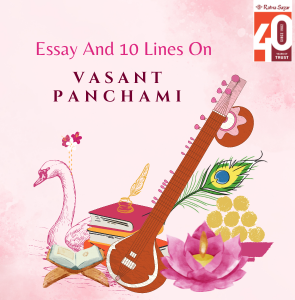Among the most colourful Hindu festivals, one is Vasant Panchami. It is celebrated at the beginning of spring. Today, we will learn to write 10 lines on Vasant Panchami and we will also learn an essay on Vasant Panchami.

10 Lines on Vasant Panchami
- Vasant Panchami is a Hindu festival celebrated on the fifth day of the lunar month of Magha (January or February).
- The festival honours Goddess Saraswati who is the giver of knowledge, wisdom, learning and art.
- Legend has it that Goddess Saraswati blessed the Sanskrit poet Kalidasa on this day, transforming him into a renowned poet.
- Devotees seek Goddess Saraswati’s wisdom and intelligence through prayers on Vasant Panchami.
- The festival signifies the transition from winter to spring, with vibrant yellow mustard fields blooming around this time.
- Considered an auspicious period, it is ideal for starting new ventures like marriages, house purchases and job beginnings.
- Schools and colleges celebrate the festival with prayers and cultural programmes, seeking to invoke the blessings of Goddess Saraswati for knowledge and wisdom.
- Devotees offer boondi, ladoo, sweet rice with saffron and dry fruits, as well as mango wood, coconut, Ganga water and fruits to Goddess Saraswati.
- In Punjab, people enjoy traditional dishes like Maake ki Roti and Sarson Ka Saag during the festival, while in Bihar people celebrate with offerings like Kheer, Malpua, Bundi and other traditional festive dishes.
- Murti Visthapan day involves elaborate processions, culminating in the immersion of Maa Saraswati idols in the Ganga and enjoyment with prasad.
Essay on Vasant Panchami
Vasant Panchami is a Hindu festival celebrated on the fifth day of the lunar month of Magha which usually falls in the months of January or February. This festival honours the goddess Saraswati who is known as the deity of knowledge, wisdom, learning and art. Legend has it that on Vasant Panchami, Saraswati blessed the great Sanskrit poet Kalidasa, transforming him into a highly renowned poet. Devotees seek Saraswati’s wisdom and intelligence by praying to her on this day.
This festival marks the transition from winter to spring. Around the times of Vasant Panchami mustard fields bloom in vibrant yellow. This auspicious period is considered ideal for initiating new ventures like marriages, house purchases and job starts.
This festival is also observed in educational institutions such as schools and colleges, where students seek the blessings of Goddess Saraswati for wisdom, learning and knowledge. Students and teachers adorn themselves in new attire, offer prayers to the goddess of knowledge and arrange various song and dance programs to appease her. Devotees present offerings of boondi and ladoo to Goddess Saraswati. Sweet rice infused with saffron and dry fruits becomes a common preparation in households. Mango wood, coconut, Ganga water and fruits are also offered.
In the state of Punjab, it is customary to relish Maake ki Roti and Sarson Ka Saag during this festival. Meanwhile, Bihar celebrates Saraswati Puja by presenting delectables like Kheer, Malpua and Bundi to the goddess. Traditional festive dishes such as khichuri, mixed vegetables, kesar halwa, kesari bhaat, payesh, begun bhaja, sondesh and rajbhog are prepared as offerings on this special day. On Murti Visthapan day, elaborate processions take place, culminating in the immersion of Maa Saraswati idols in the sacred waters of the Ganga with solemnity. The celebration is completed by savouring Dahi Chura along with gur and banana.
Read More…
Essay And 10 Lines on Chhatrapati Shivaji Maharaj
Short Essay And 10 Lines on Netaji Subhas Chandra Bose
Insightful Short Essays and 10 Lines on Holi
Essay And 10 Lines On Sarojini Naidu – Sarojini Naidu Birth Anniversary

